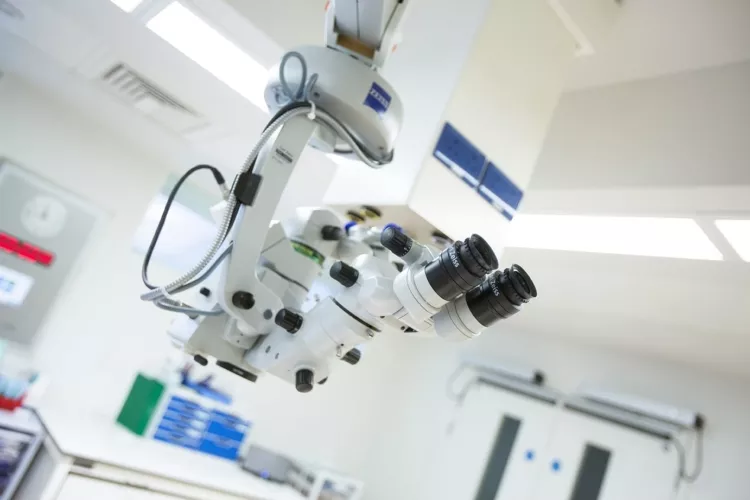Wavefront LASIK surgery has a huge advantage over other laser eye surgery methods in that it analyses and maps the whole of the eye – and so the entire sight process – instead of merely the cornea’s surface. When it comes to sight and a person’s visual focus, imperfections are as unique as a fingerprint. A wavefront sensor can pick up any flaw in the vision, whereas other methods will only pick up flaws in a specific area, such as the cornea.
Before the introduction of wavefront technology, laser eye surgery could already treat conditions such as astigmatism, short-sightedness, and long sightedness. Now, Wavefront eye surgery techniques have opened the doors for expert ophthalmologists to treat a much wider range of sight problems than ever before. The forms of wavefront laser eye surgery available at Optegra are called LASIK, PRESBYOND, SMILE, and LASEK.
How Does Wavefront Laser Eye Surgery Work?
Wavefront laser eye surgery, an advanced form of LASIK (Laser-Assisted In Situ Keratomileusis), works by creating a highly detailed map of the eye. This technology allows for a more precise and individualised correction compared to traditional LASIK. Here’s how it works:
- Mapping the Eye: Wavefront technology uses a device to send light waves through the eye to the retina. As these waves bounce back, they are measured, creating a detailed 3D map of the eye. This map highlights all the imperfections in the way the eye processes light, including higher-order aberrations, which are complex vision errors that standard tests might not detect.
- Customised Treatment Plan: The surgeon develops a customised treatment plan based on this detailed wavefront map. This plan is programmed into the excimer laser, which is used to reshape the cornea.
- Reshaping the Cornea: During the surgery, the laser precisely removes microscopic amounts of corneal tissue according to the unique contours of the patient’s eye. This reshaping corrects refractive errors and improves the eye’s ability to focus light accurately onto the retina.
- Enhanced Precision and Outcomes: The customisation allowed by wavefront technology means that laser eye surgery is tailored to the individual’s unique eye characteristics, potentially improving clarity and contrast sensitivity and reducing issues like glare and halos.
In terms of success rates, wavefront laser eye surgery generally has high success rates. Most patients achieve 20/20 vision or better after the surgery. However, success rates can vary based on factors like the patient’s initial vision prescription, age, and other eye conditions.

LASIK Wavefront Surgery
LASIK stands for ‘laser assisted in-situ keratomileusis’. This procedure is suitable for wavefront aberrations or abnormalities as well as treating short and long-sightedness and astigmatism. A blade-free process, LASIK Wavefront laser eye surgery uses computer technology to improve vision in as little as 15 minutes.
In a wavefront LASIK treatment, a laser makes a thin flap on the cornea to adjust the tissue beneath, correcting the eye’s refractive error. The thin flap is then replaced for the natural healing, and most patients feel the benefit within 24 hours. LASIK wavefront is usually a quick procedure and can be performed under a local anaesthetic.
What is the Difference Between LASIK Wavefront & LASEK Wavefront?
The key difference between LASIK, SMILE, LASEK and PRESBYOND Wavefront lies in how the cornea is accessed during the surgery:
The key difference between LASIK Wavefront and LASEK Wavefront lies in how the cornea is accessed during the surgery:
LASIK Wavefront: In LASIK (Laser-Assisted In Situ Keratomileusis) Wavefront, a thin flap is created on the cornea using a microkeratome blade or a femtosecond laser. This flap is lifted to expose the underlying corneal tissue. The excimer laser, guided by the wavefront technology’s detailed map of the eye’s imperfections, then reshapes the cornea. Afterward, the flap is repositioned. LASIK Wavefront is generally preferred for its quicker healing time and minimal discomfort.
LASEK Wavefront: LASEK (Laser Epithelial Keratomileusis) Wavefront involves loosening and pushing aside the cornea’s epithelial (surface) layer rather than creating a flap. The underlying cornea is then reshaped using the excimer laser, guided by wavefront mapping. Afterward, the epithelial layer is repositioned. LASEK is often chosen for patients with thinner corneas or for those who engage in activities where a corneal flap might be at risk.
SMILE Small Incision Lenticule Extraction involves creating a keyhole incision from which a lenticular (tissue-causing prescription is removed.
PRESBYOND LASIK, for those who want independence from spectacles, targets one eye for mid-range and near vision and one eye for mid-range and distance vision. Both eyes then work harmoniously to provide excellent vision for all desired distances.
Who is suitable for Wavefront Laser Eye Surgery?
Wavefront laser eye surgery is suitable for a wide range of individuals. Suitability largely depends on specific eye conditions, general health, and lifestyle factors. Here are some key criteria for suitability:
Age and Stability of Vision: Candidates with a stable vision prescription should be over 18 years old.
Candidates should have healthy eyes and no history of significant eye diseases such as keratoconus, advanced glaucoma, cataracts, or severe dry eye syndrome.
Adequate Corneal Thickness: Since the procedure involves reshaping the cornea, there must be sufficient corneal thickness. People with thin corneas might be more suited to SMILE or LASEK Wavefront than LASIK Wavefront.
Refractive Errors within Certain Limits: Wavefront surgery is most effective for people with certain degrees of myopia (short-sightedness), hyperopia (long-sightedness), and astigmatism
Good General Health: Candidates should be in overall good health. Certain systemic conditions may affect the healing process and suitability for the surgery.
Interested In Wavefront Laser Eye Surgery?
Please arrange for a no-obligation, free virtual consultation, or arrange a callback with one of our experts.

By Author: Alex J Shortt
Mr Shortt is a leading ophthalmic surgeon and an expert in the fields of cornea, cataract and refractive surgery.
Medically Reviewed Date: 13th February 2024
